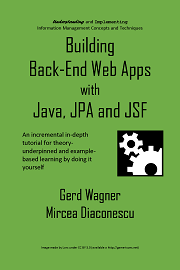 In
addition to the six tutorials
listed below. we also
offer a book
not only containing the
tutorials, but additional
materials (such as a glossary,
additional practice projects and
quiz questions).
In
addition to the six tutorials
listed below. we also
offer a book
not only containing the
tutorials, but additional
materials (such as a glossary,
additional practice projects and
quiz questions).
 This 6-part in-depth tutorial
shows how to build distributed
Java web applications with Java
Server Faces (JSF) as the user
interface technology, the Java
Persistence API (JPA) as the
object-to-storage mapping
technology, and a MySQL
database.
This 6-part in-depth tutorial
shows how to build distributed
Java web applications with Java
Server Faces (JSF) as the user
interface technology, the Java
Persistence API (JPA) as the
object-to-storage mapping
technology, and a MySQL
database.
- Building a Minimal Java Web App with JPA and JSF in Seven Steps
- Adding Constraint Validation
- Dealing with Enumerations
- Managing Unidirectional Associations
- Managing Bidirectional Associations
- Handling Class Hierarchies
Book detailsBuy the book Getting Ready to Run the Apps
1 Building a Minimal Java Web App with JPA and JSF in Seven Steps
 An introductory tutorial for
"early" app developers about
developing Java web applications
with minimal effort
An introductory tutorial for
"early" app developers about
developing Java web applications
with minimal effort
In this first part of our 6-part tutorial we summarize the web's foundations and show how to build a distributed Java web application with minimal effort using Java Server Faces (JSF) as the user interface technology, the Java Persistence API (JPA) as the object-to-storage mapping technology, and a MySQL database.
Read the tutorial Get the code
2 Adding Constraint Validation
 A medium-level tutorial about
developing Java web applications
with constraint validation using
Bean Validation annotations
A medium-level tutorial about
developing Java web applications
with constraint validation using
Bean Validation annotations
This tutorial shows how to build a simple Java web application with constraint validation using JPA, JSF and Bean Validation annotations. The minimal Java web app that we have discussed in the first part of this 6-part tutorial has been limited to support the minimum functionality of a data management app only. However, it did not take care of preventing the users from entering invalid data into the app's database. In this second part of the tutorial we show how to express integrity constraints in a JavaBean model class with the help of Bean Validation annotations, and how to perform constraint validation both in the model part of the app and in the HTML5 user interface.
Read the tutorial Get the code
3 Dealing with Enumerations
 A medium-level tutorial about
developing Java web applications
with enumeration attributes
A medium-level tutorial about
developing Java web applications
with enumeration attributes
In all application domains, there
are string-valued attributes
with a fixed set of possible
string values. These attributes
are called enumeration
attributes, and the
fixed value sets defining their
possible string values are
called
enumerations. For
allowing user input to an
enumeration attribute, we can
use the UI concept of a
(drop-down) selection
list, which may be
implemented with an HTML
select
element. For user input to
a single-valued
enumeration attribute, a
radio button group can
be used instead of a single
selection list, while for user
input to a multi-valued
enumeration attribute, a
checkbox group can be
used instead of a multiple
selection list.
This tutorial shows how to build a Java web app where model classes have enumeration attributes implemented with the help of Java enums, and where the JSF Facelet templates are taking care of selection lists and choice widgets.
Read the tutorial Get the code
4 Managing Unidirectional Associations
 An advanced tutorial about
developing Java web applications
with unidirectional associations
An advanced tutorial about
developing Java web applications
with unidirectional associations
The three example apps that we have discussed in previous chapters, the minimal app, the validation app and the enumeration app, have been limited to managing the data of one object type only. A real app, however, has to manage the data of several object types, which are typically related to each other in various ways. In particular, there may be associations and subtype (inheritance) relationships between object types. Handling associations and subtype relationships are advanced issues in software application building. They are often not sufficiently discussed in software development text books and not well supported by application development frameworks. In this part of the tutorial, we show how to deal with unidirectional associations, while bidirectional associations and subtype relationships are covered in parts 5 and 6.
Read the tutorial Get the code
5 Managing Bidirectional Associations
 An advanced tutorial about
developing Java web applications
with bidirectional associations
An advanced tutorial about
developing Java web applications
with bidirectional associations
This tutorial shows how to build a Java web app that takes care of the object types Author, Publisher and Book as well as the bidirectional associations between Book and Author and between Book and Publisher. The app supports the four standard data management operations (Create/Read/Update/Delete). It extends the example app of part 4 by adding code for handling derived inverse reference properties, but it needs to be enhanced by adding subtype handling.
Read the tutorial Get the code
6 Handling Subtype Relationships in Class Hierarchies
 An advanced tutorial about
subtyping in Java web
applications
An advanced tutorial about
subtyping in Java web
applications
This tutorial shows how to build a Java web app that manages subtype (inheritance) relationships between object types.

